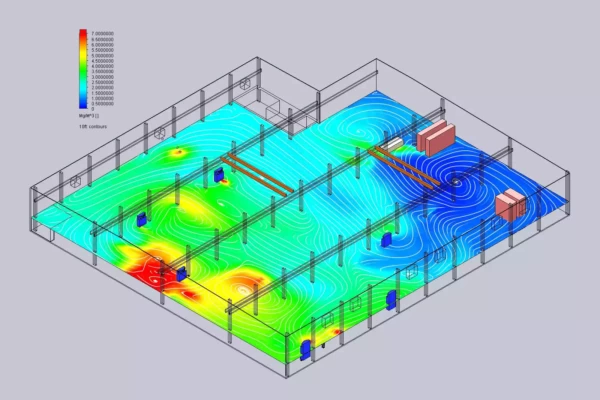DUST TYPES IN ALKALINE BATTERY PRODUCTION
Alkaline batteries consist of a manganese dioxide (MnO2) cathode and a zinc (Zn) anode in an electrolyte solution made of potassium hydroxide (KOH) and water. During the discharge process, zinc from the anode reacts with potassium hydroxide in the electrolyte to form zinc oxide (ZnO) and hydrogen (H2) gas. The electrodes are separated by a non-woven fabric and contained in a steel canister. The most commonly known alkaline batteries are the AA, AAA, C, D and 9V batteries used in common household electronics.
Alkaline battery manufacturing produces toxic dust and fumes at several stages of production, including electrode production and cell assembly. Several different types of dust may result from alkaline battery production.
- Cathode materials: Manganese dioxide (MnO2), as a fine powder, is mixed with graphite powder to improve conductivity. Barium sulfate (BaSO4) powder may be used as a binder.
- Anode materials: A fine zinc powder is used as the negative anode. The zinc powder is mixed with a gelling agent to create a thick paste. Button cell batteries may also contain a small amount of mercury.
Workers may also be exposed to metalworking dust during some stages of alkaline battery production. The casing (console) is usually made of nickel-plated steel and formed using a deep-drawing press and punch system. A brass pin is inserted along the central axis; this acts as an electron collector.
 EXPOSURE RISKS FOR ALKALINE BATTERY DUST
EXPOSURE RISKS FOR ALKALINE BATTERY DUST
Many of the materials used in alkaline battery manufacturing are considered to be hazardous or toxic for humans. Specific risks for materials used in alkaline batteries include:
- Zinc: While zinc is an essential nutrient, inhaling large quantities of zinc dust is hazardous. Zinc exposure in battery manufacturing can cause acute or chronic respiratory effects, including shortness of breath, coughing, chest pain, and a flu-like condition called metal fume fever. Long-term exposure to high levels of zinc dust or fumes may lead to a condition called “zinc shakes” or “zinc chills.” Zinc dust or fumes can also cause irritation and corrosion of the eyes, skin, and mucous membranes.
- Manganese/Manganese Dioxide: Inhalation of manganese dioxide dust can irritate the respiratory tract and cause symptoms such as coughing, wheezing, and shortness of breath. Long-term exposure to high levels of manganese dioxide can also cause neurological effects, including behavioral changes, cognitive deficits, and mood disorders. Chronic exposure to manganese dust can lead to a condition called manganism, which is characterized by symptoms similar to Parkinson’s disease, including tremors, muscle rigidity, and difficulty with balance and movement. Skin contact with manganese dioxide can cause irritation and dermatitis.
- Graphite: Graphite is generally considered to be a low-toxicity material, but exposure to graphite powder can still cause irritation to the eyes, nose, and throat and may also cause coughing and sneezing. If large quantities of graphite dust are inhaled, it can accumulate in the lungs and cause lung damage, a condition known as pneumoconiosis.
- Barium sulfate: Occupational exposure to barium sulfate can cause irritation of the eyes, skin, and respiratory system. Inhaling or ingesting significant amounts of the substance can lead to symptoms such as nausea, vomiting, diarrhea, abdominal pain, and muscle weakness. Chronic exposure to barium sulfate can also lead to respiratory problems and changes in heart rhythm.
- Metalworking dust: Metalworking dust created during production of the steel casings and pins for alkaline batteries can cause respiratory problems such as bronchitis, asthma, and lung cancer. Nickel used for coating the battery casings can also cause allergic reactions. Exposure to certain elements found in steel or steel alloys is linked to neurological effects.
COMBUSTION RISKS IN ALKALINE BATTERY MANUFACTURING
Some of the materials used in alkaline battery manufacturing are highly combustible if the dust is not controlled. A combustible dust explosion can occur when battery powders form an airborne cloud of dust under containment in the presence of oxygen and an ignition source. In alkaline battery production, the materials of greatest concern are zinc powder and graphite powder, both of which can be highly explosive under the right conditions. It is important to take steps to prevent the accumulation of zinc or graphite powders in the air through the use of engineering controls such as dust collection.
Manufacturers working with potentially combustible battery dust should conduct a Dust Hazard Analysis (DHA) in compliance with National Fire Prevention Association (NFPA) Standard 652: Standard on the Fundamentals of Combustible Dust. A DHA will give manufacturers a better understanding of the explosibility of their material and specific combustion hazards related to lead-acid battery manufacturing processes.
Learn more about mitigating combustion risks for battery dusts in the Visual Guide to Combustible Dust Collection.
 REGULATIONS ALKALINE BATTERY MANUFACTURING
REGULATIONS ALKALINE BATTERY MANUFACTURING
The Occupational Health and Safety Administration (OSHA) sets Permissible Exposure Limits (PELs) for hazardous materials used in battery manufacturing, such as zinc, manganese and barium sulfate. These are usually expressed as an 8-hour Time-Weighted Average (TWA). These PELs carry the force of law; manufacturers are responsible for having controls in place to ensure that workers are not exposed in levels above the PEL. Manufacturers can find the PEL specific to the materials they are working with in OSHA’s Annotated PEL Tables. PELs relevant for alkaline battery manufacturing include:
- Manganese: 5 mg/m³ (as Mn or compounds)
- Barium sulfate: 15 mg/m³ (total dust), 5 mg/m³ (respirable fraction)
- Zinc oxide: 5 mg/m³ (as ZnO)
- Graphite: 15 mppcf (respirable fraction)
The National Institute of Occupational Safety and Health (NIOSH) and the American Conference of Governmental Industrial Hygienists (ACGIH) both set their own Recommended Exposure Limits (RELs) or Threshold Value Limits (TLVs) for hazardous substances based on scientific evidence of harm. These recommended limits are frequently lower than the OSHA-required PEL. While these limits do not have the force of law, battery manufacturers may wish to aim for more stringent limits to keep employees safe and prepare for future regulatory changes.
Manufacturers working with potentially combustible dust, such as zinc and graphite powders, must also comply with all regulations related to combustible dust. OSHA’s Combustible Dust National Emphasis Program (NEP) outlines policies and procedures for inspecting workplaces that create or handle combustible dusts. Combustible dusts are regulated under OSHA’s General Duty Clause (Section 5(a)(1)) with additional requirements under the Hazardous Locations (§1910.307), Hazard Communication (§1910.1200) and Housekeeping (§1910.22) standards. In addition, manufacturers dealing with combustible dusts must follow NFPA standards for handling combustible materials, including NFPA 652, NFPA 654, NFPA 484, NFPA 68, and NFPA 69.
Battery manufacturers must also consider Environmental Protection Agency (EPA) rules for emission control and material storage and disposal of hazardous materials. These rules include the Clean Air Act, Clean Water Act and Resource Conservation and Recovery Act (RCRA).
MORE DUST TYPES
SOLUTIONS FOR ALKALINE BATTERY DUST COLLECTION
RoboVent can help you develop a dust control strategy to control hazardous dusts, prevent worker exposure, reduce combustion risks and ensure regulatory compliance. We are working with battery manufacturers to create safer, healthier work environments and protect employees from hazardous materials used in battery production.
Engineering controls such as dust collection and air filtration are the best way to protect workers and facilities from hazardous dusts created during various stages of battery manufacturing. RoboVent Senturion is a powerful, flexible dust collector that can be adapted to a wide range of applications, including the collection of dust produced in battery manufacturing. RoboVent engineers can develop a customized solution for battery dust control, including:
- Hood, ductwork and system design to maximize capture rates and minimize disturbance of usable materials or sensitive manufacturing atmospheres
- Ventmapping engineering services
- Filter selection, including HEPA filtration for ultrafine particulate
- Indoor air quality and exposure testing
- Regulatory compliance
Alkaline Battery Dust Collection Collectors
Clean Air Technology Services
CONTACT US
Contact one of our industrial dust experts to gain the advantage against dust-generating processes and applications.








